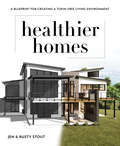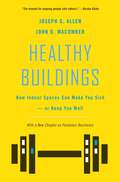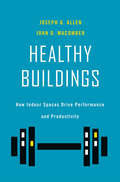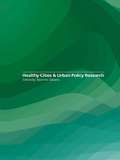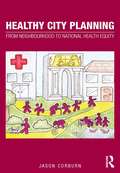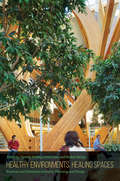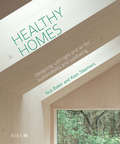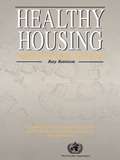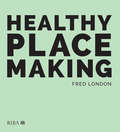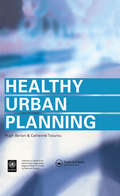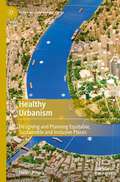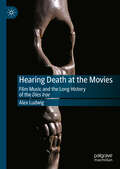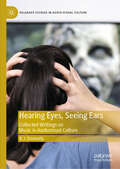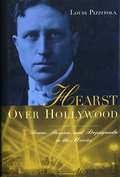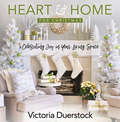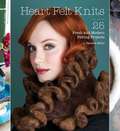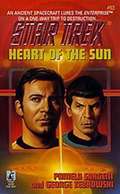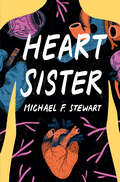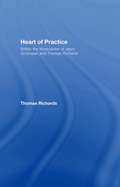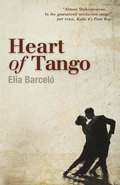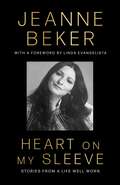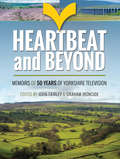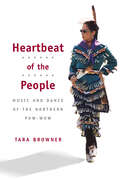- Table View
- List View
Healthier Homes: A Blueprint for Creating a Toxin-Free Living Environment
by Jen Stout Rusty StoutMost of us spend 90 percent of our time indoors, but our indoor environments could be causing us significant harm. Everything from flooring to paints to insulation contains chemicals known to contribute to health problems such as cardiovascular disease and cancer. In this book, Jen and Rusty Stout, nationally recognized healthy home building innovators, teach you how to think like a builder so that you can construct a new home or upgrade an existing one to put wellness first. Making smart choices when it comes to building materials, moisture protection, and more can make all the difference in reducing your family&’s exposure to toxins and living a healthier life.Whether you are a home buyer, a homeowner working with a professional builder, a building contractor, or a DIY-er, Healthier Homes walks you through key considerations such as Site selectionDesigning a living space that meets your family&’s unique needsMaterial choices for the exterior and interiorAir and water qualitySourcing home furnishings and finishesExisting home upgradesMold remediation
Healthy Buildings: How Indoor Spaces Can Make You Sick—or Keep You Well
by John D. Macomber Joseph G. AllenA revised and updated edition of the landmark work the New York Times hailed as “a call to action for every developer, building owner, shareholder, chief executive, manager, teacher, worker and parent to start demanding healthy buildings with cleaner indoor air.”For too long we’ve designed buildings that haven’t focused on the people inside—their health, their ability to work effectively, and what that means for the bottom line. An authoritative introduction to a movement whose vital importance is now all too clear, Healthy Buildings breaks down the science and makes a compelling business case for creating healthier offices, schools, and homes.As the COVID-19 crisis brought into sharp focus, indoor spaces can make you sick—or keep you healthy. Fortunately, we now have the know-how and technology to keep people safe indoors. But there is more to securing your office, school, or home than wiping down surfaces. Levels of carbon dioxide, particulates, humidity, pollution, and a toxic soup of volatile organic compounds from everyday products can influence our health in ways people aren’t always aware of.This landmark book, revised and updated with the latest research since the COVID-19 pandemic, lays out a compelling case for more environmentally friendly and less toxic offices, schools, and homes. It features a concise explanation of disease transmission indoors, and provides tips for making buildings the first line of defense. Joe Allen and John Macomber dispel the myth that we can’t have both energy-efficient buildings and good indoor air quality. We can—and must—have both. At the center of the great convergence of green, smart, and safe buildings, healthy buildings are vital to the push for more sustainable urbanization that will shape our future.
Healthy Buildings: How Indoor Spaces Drive Performance and Productivity
by John D. Macomber Joseph G. Allen“This book should be essential reading for all who commission, design, manage, and use buildings—indeed anyone who is interested in a healthy environment.” —Norman Foster A forensic investigator of “sick buildings” and Director of Harvard’s Healthy Buildings Program teams up with a CEO-turned–Harvard Business School professor to reveal the secrets of a healthy building—and unlock one of the greatest business opportunities of our time. By the time you reach eighty, you will have spent seventy-two years of your life indoors. Like it or not, humans have become an indoor species. This means that the people who design, build, and maintain our buildings can have a major impact on our health. Ever feel tired during a meeting? That’s because most offices and conference rooms are not bringing in enough fresh air. When that door opens, it literally breathes life back into the room. But there is a lot more acting on your body that you can’t feel or see. From our offices and homes to our schools and hospitals, the indoor spaces where we work, learn, play, eat, and heal have an outsized influence on our performance and wellbeing. They affect our creativity, focus, and problem-solving ability and can make us sick—dragging down profits in the process. Charismatic pioneers of the healthy building movement who have paired up to combine the cutting-edge science of Harvard’s School of Public Health with the financial know-how of the Harvard Business School, Joseph Allen and John Macomber lay out the science of healthy buildings and make the business case for owners, developers, and CEOs. They reveal the 9 Foundations of a Healthy Building, and show how tracking health performance indicators with smart technology can boost performance and create economic value. While the “green” building movement tackled energy, waste, and water, the new healthy building movement focuses on the most important (and expensive) asset of any business: its people.
Healthy Cities and Urban Policy Research
by Takehito TakanoHealthy Cites and Urban Policy Research is a collection of papers by leading experts from academia or international organisations who have been involved in the Healthy Cities Movement. It is the first academic work to combine public health with urban planning. Contemporary issues from various perspectives are included which address evaluation, evidence-based practice, accountability, community participation and information technology.
Healthy City Planning: From Neighbourhood to National Health Equity (Planning, History and Environment Series)
by Jason CorburnHealthy city planning means seeking ways to eliminate the deep and persistent inequities that plague cities. Yet, as Jason Corburn argues in this book, neither city planning nor public health is currently organized to ensure that today’s cities will be equitable and healthy. Having made the case for what he calls ‘adaptive urban health justice’ in the opening chapter, Corburn briefly reviews the key events, actors, ideologies, institutions and policies that shaped and reshaped the urban public health and planning from the nineteenth century to the present day. He uses two frames to organize this historical review: the view of the city as a field site and as a laboratory. In the second part of the book Corburn uses in-depth case studies of health and planning activities in Rio de Janeiro, Nairobi, and Richmond, California to explore the institutions, policies and practices that constitute healthy city planning. These case studies personify some of the characteristics of his ideal of adaptive urban health justice. Each begins with an historical review of the place, its policies and social movements around urban development and public health, and each is an example of the urban poor participating in, shaping, and being impacted by healthy city planning.
Healthy Environments, Healing Spaces: Practices and Directions in Health, Planning, and Design
by Timothy Beatley, Carla Jones, and Reuben RaineyThis collection of essays by leading scholars and practitioners addresses a timely and essential question: How can we design, plan, and sustain built environments that will foster health and healing? With a salutogenic (health-promoting) focus, Healthy Environments, Healing Spaces addresses a range of contemporary issues, including health equity, biophilic cities, healthcare facility design, environmental health, aging in place, and food systems planning.Contributors: Ellen Bassett ● Timothy Beatley ● Emily Chmielewski ● Jason Corburn ● Tanya Denckla Cobb ● Tye Farrow ● Ann Forsyth ● Howard Frumkin ● Judith H. Heerwagen ● J. David Hoglund ● Carla Jones ● Andrew Mondschein ● Christina Mullen ● Reuben Rainey ● Samina Raja ● Jennifer Whittaker
Healthy Homes: Designing with light and air for sustainability and wellbeing
by Nick Baker Koen SteemersIt is widely acknowledged that there is an urgent need to transform our housing stock to a better energy performance level. However, improving energy performance should not result in a negative impact on the health, wellbeing and the comfort of building occupants. There are many energy-neutral features that can be incorporated at small or zero cost which have a positive effect on wellbeing. This book aims to outline and discuss these aspects of building design. The issue of health and wellbeing has already entered into design advice for the workplace, where productivity and absenteeism are often used as indicators. This book concentrates on residential buildings, notably mass housing and affordable strategies, for which new, more socially and health-oriented indicators are being developed. Provides practical design guidance based on scientific evidence Explores both physical and psychological wellbeing Focuses on the home and immediate domestic environment Structured in an accessible way for architects and designers.
Healthy Housing: A practical guide
by Ray RansonThe objective of this book is to encourage administrations to formulate a sound housing policy to solve basic health-related housing problems and to meet WHO's objective of healthful housing for all by the year 2000. The principles of healthy housing have universal applicability, as most countries of the developed world have areas of slum or otherwise insanitary housing.It is hoped that this guide will be used extensively as a reference to basic health requirements for new housing and human settlements and as a guide for assessing the hygienic quality of existing housing. The book would sit well alongside inter-professional and community education programmes.
Healthy Placemaking: Wellbeing Through Urban Design
by Fred LondonIn modern-day society the main threats to public health are now considered ‘avoidable illnesses’, which are often caused by a lack of exercise and physical activity. Research suggests that architectural and urban design strategies play an important role in reducing the amount of avoidable illnesses by enabling physical activity through healthier streets. Practitioners must now consider how they can encourage people to lead healthier lifestyles and improve health through urban design. This book presents the path to healthier cities through six core themes - urban planning, walkable communities, neighbourhood building blocks, movement networks, environmental integration and community empowerment. Each theme is presented with an overview of the issues, the solutions and how to apply them practically with exemplars and precedents. It's an essential text that provides practitioners across urban design, architecture, master planning with the necessary knowledge and guidance to understand their role in producing healthier places and put it in to practice.
Healthy Urban Planning
by Hugh Barton Catherine TsourouHealthy Urban Planning aims to refocus urban planners on the implications of their work for human health and well-being. If many of the problems faced in cities are to be resolved, improving health will be the fundamental goal of urban planners. Poor housing, poverty, stress, pollution, and lack of access to jobs, goods and services all impact upon health. This book provides practical advice on ways to integrate health and urban planning and will be essential reading for urban planners, developers, urban designers, transport planners, and those working in the fields of regeneration and renewal. It will also be of interest to those with an interest in sustainable development.
Healthy Urbanism: Designing and Planning Equitable, Sustainable and Inclusive Places (Planning, Environment, Cities)
by Helen PineoThe globally distributed health impacts of environmental degradation and widening inequalities require a fundamental shift in understandings of healthy urbanism. This book redefines the meaning and form of healthy urban environments, urging planners and design professionals to consider how their work impacts population health and wellbeing at multiple spatial and temporal scales. The concepts of equity, inclusion and sustainability are central to this framing, reversing the traditional focus on individuals, their genes and ‘lifestyle choices’ to one of structural factors that affect health. Integrating theory and concepts from social epidemiology, sustainable development and systems thinking with practical case studies, this book will be of value for students and practitioners.
Hearing Death at the Movies: Film Music and the Long History of the Dies Irae
by Alex LudwigThe Dies Irae is a melody that composers of film music have employed in hundreds of films, ranging from Metropolis to The Shining, and Star Wars. It is a product of more than 800 years of musical transformation, finding purchase in a variety of musical environments, including the church, the concert hall, and the cinema. Based on a corpus of nearly 300 films, Hearing Death At the Movies models two new ways of thinking about the Dies Irae. First, it identifies three different versions of the melody, each of which signifies a different function of film music. Second, it traces the semantic shift of the Dies Irae from its religious roots to its secular perception as a symbol of death. This study of the most widely-used theme in film music history will change how you listen to movies.
Hearing Eyes, Seeing Ears: Collected Writings on Music in Audiovisual Culture (Palgrave Studies in Audio-Visual Culture)
by K.J. DonnellyThis book approaches music in audiovisual culture as a complex merged signal rather than as a simple ‘addition’ to the images of film. The audiovisual is central to modern culture, with screens and speakers (including headphones) dominating communication, leisure and drama. While this book mostly addresses film, it also deals with sister media such as television and video games, registering that there is a ‘common core’ of synchronized image and sound at the heart of these different but related media. The traditions of sound and what Michel Chion calls ‘audiovision’ (1994), including principles of accompaniment and industrial processes from film, have been retained and developed in other media. This book engages with the rich history, and varied genres, different traditions and variant strategies of audiovisual culture. However, it also points to and emphasizes the ‘common core’ of flat moving images and synchronized sound and music which marks a dominant in electronic media culture (what might be called ‘screen and speaker/diaphragm culture’). Addressing music as both diegetic and non-diegetic, as both songs and score, the analyses presented in this book aim to attend the precise interaction between music and other elements of audiovisual culture as defining overall configurations. While many writings about music in audiovisual culture focus on ‘what it communicates’, its processes are more complicated and can form a crucial semi-conscious (or perhaps unconscious) background. While music’s effect might be far from simple and unified, part of screen music’s startling effect comes from its unity with the image. Cross-modal ‘crosstalk’ between sound and image forms a whole new signal of its own. Each chapter marks a case study making for a varied collection that embraces rich history and different traditions, as well as the distinct aesthetic boldness of different genres and formats.
Hearst Over Hollywood: Power, Passion, and Propaganda in the Movies
by Louis PizzitolaHollywood—crossroads of filmmaking, mythmaking, and politics—was dominated by one man more than any other for most of its history. It was William Randolph Hearst who understood how to use cinema to exploit the public's desire for entertainment and to create film propaganda to further his own desire for power. From the start, Hearst saw his future and the future of Hollywood as one and the same. He pioneered and capitalized on the synergistic relationship between yellow journalism and advertising and motion pictures. He sent movie cameramen to the inauguration of William McKinley and the front lines of the Spanish-American War. He played a prominent role in organizing film propaganda for both sides fighting World War I. By the 1910s, Hearst was producing his own pictures—he ran one of the first animation studios and made many popular and controversial movie serials, including The Perils of Pauline (creating both the scenario and the catchphrase title) and Patria. As a feature film producer, Hearst was responsible for some of the most talked-about movies of the 1920s and 1930s. Behind the scenes in Hollywood, Hearst had few equals—he was a much-feared power broker from the Silent Era to the Blacklisting Era. Hearst Over Hollywood draws on hundreds of previously unpublished letters and memos, FBI Freedom of Information files, and personal interviews to document the scope of Hearst's power in Hollywood. Louis Pizzitola tells the hidden story of Hearst's shaping influence on both film publicity and film censorship—getting the word out and keeping it in check—as well as the growth of the "talkies," and the studio system. He details Hearst's anti-Semitism and anti-Communism, used to retaliate for Citizen Kane and to maintain dominance in the film industry, and exposes his secret film deal with Germany on the eve of World War II. The author also presents new insights into Hearst's relationships with Marion Davies, Will Hays, Louis B. Mayer, Franklin D. Roosevelt, Mussolini, Hitler, and the Kennedys. Hearst Over Hollywood is a tour de force of biography, cultural study, and film history that reveals as never before the brilliance and darkness of Hearst's prophetic connection with Hollywood.
Hearst Over Hollywood: Power, Passion, and Propaganda in the Movies (Film and Culture Series)
by Louis PizzitolaHollywood—crossroads of filmmaking, mythmaking, and politics—was dominated by one man more than any other for most of its history. It was William Randolph Hearst who understood how to use cinema to exploit the public's desire for entertainment and to create film propaganda to further his own desire for power. From the start, Hearst saw his future and the future of Hollywood as one and the same. He pioneered and capitalized on the synergistic relationship between yellow journalism and advertising and motion pictures. He sent movie cameramen to the inauguration of William McKinley and the front lines of the Spanish-American War. He played a prominent role in organizing film propaganda for both sides fighting World War I. By the 1910s, Hearst was producing his own pictures—he ran one of the first animation studios and made many popular and controversial movie serials, including The Perils of Pauline (creating both the scenario and the catchphrase title) and Patria. As a feature film producer, Hearst was responsible for some of the most talked-about movies of the 1920s and 1930s. Behind the scenes in Hollywood, Hearst had few equals—he was a much-feared power broker from the Silent Era to the Blacklisting Era.Hearst Over Hollywood draws on hundreds of previously unpublished letters and memos, FBI Freedom of Information files, and personal interviews to document the scope of Hearst's power in Hollywood. Louis Pizzitola tells the hidden story of Hearst's shaping influence on both film publicity and film censorship—getting the word out and keeping it in check—as well as the growth of the "talkies," and the studio system. He details Hearst's anti-Semitism and anti-Communism, used to retaliate for Citizen Kane and to maintain dominance in the film industry, and exposes his secret film deal with Germany on the eve of World War II. The author also presents new insights into Hearst's relationships with Marion Davies, Will Hays, Louis B. Mayer, Franklin D. Roosevelt, Mussolini, Hitler, and the Kennedys. Hearst Over Hollywood is a tour de force of biography, cultural study, and film history that reveals as never before the brilliance and darkness of Hearst's prophetic connection with Hollywood.
Heart & Home for Christmas: Celebrating Joy in Your Living Space
by Victoria DuerstockAs a writer, teacher, and speaker with a busy work and family life, Victoria Duerstock understands that all the tasks of the holiday season can make it easy to forget the true joy that Christmas can bring. In Heart & Home for Christmas, Duerstock brings her mission to inspire hope for God's purpose, and her 20 years of experience in the furniture and design industry together, connecting Scripture with design elements and easy decorating tips in a way that reflects the true spirit of Christmas. The devotions and holiday decorating tips will encourage spiritual growth and inspiration to have both a captivating heart and home at Christmas. Praise for Heart & Home: Design Basics for Your Soul and Living Space Seldom do I discover a book which ministers to mind, body and soul, but Victoria Duerstock’s Heart & Home is just such a jewel! I was immediately drawn to the unique design elements through color photographs, and especially the carefully selected accompanying Scripture, meditation and prayer. All of these work together to address one small element of life on which I can meditate all day long (and even bring into my own home through her practical suggestions.) While I am neither an interior designer nor DIY crafter, I am someone who embraced “hygge” long before I knew what the word meant–a beauty through coziness and care. You too? Good. My gift list for this special volume is already quite lengthy... Lucinda Secrest McDowell, author Dwelling Places and Graces As I read Heart & Home, I was captivated not only by the beauty and elegance on every page and in every word, but more importantly I was inspired to see how spaces can transform lives. Creating a home is a sacred undertaking. Building a home or office that inspires, comforts, engages and transforms hearts leads to healthy individuals, families and communities. I was challenged to think about how our homes can be used to focus us on God; how every color, design and object can strengthen our soul. I hope that Victoria’s book will also inspire you and refresh your heart and home. Robert Wallstrom, CEO Vera Bradley
Heart Felt Knits
by Tamara MelloKnitting something by hand and then applying the centuries-old technique of wet felting results in gorgeous pieces that are durable, eco-friendly, and timeless. In Heart Felt Knits, actress-turned-crafter Tamara Mello offers twenty-five knitted and felted projects, from darling nesting bowls to elegant hats, cozy wraps, and chic hair accessories. Knitters will love watching their pieces take on surprising forms and textures through the felting process. With easy-to-follow knitting patterns, simple felting instructions, helpful how-to photographs, and lavish shots of the finished projects, this special book shows knitters of all stripes how to create unique accessories and keepsakes to last a lifetime.
Heart Of The Sun (Star Trek #83)
by P Sargent G ZebrowskiWhen an abandoned space habitat is found within a distant asteroid belt, the Starship Enterprise is sent to investigate. Captain Kirk and his crew discover an artificial world full of technological marvels -- and unexpected dangers. But wonder and curiosity give way to fear when the habitat's shifting orbit sends it on a collision course with an inhabited planet within the same solar system. Now Kirk and Spock must find a way to save the planet without destroying a treasure trove of alien science, and time is running out...
Heart Sister
by Michael F. StewartAfter his twin sister, Minnie, dies in an accident, Emmitt's world goes sideways. He’s lost his best friend and it feels like the family is falling apart without her. But Minnie was an organ donor and Emmitt soon receives an anonymous thank you letter from one of the transplant recipients. Inspiration strikes, and he decides to try and put his sister back together, in spirit. He’s going to track down each organ recipient and film them to show his parents the results of Minnie’s selfless act and help them move on. But when each recipient falls short of his expectations and the star of his film, the girl who received his sister’s heart, refuses to meet him, Emmitt has to turn to extreme measures to find her. What he doesn’t know is that his "heart sister" is hiding an agonizing secret, one that could push Emmitt to the breaking point. Orca Book Publishers is pleased to offer Heart Sister in two accessible editions. The audiobook features alternate text descriptions of images, including the cover. The epub edition of this title is fully accessible.
Heart of Practice: Within the Workcenter of Jerzy Grotowski and Thomas Richards
by Thomas RichardsHeart of Practice is a unique and invaluable insight into the workings of one of theatre’s true pioneers, presented by his closest collaborator. This book charts the development of Grotowski’s dramatic research through a decade of conversations with his apprentice, Thomas Richards. Tuscany’s ‘Workcenter of Jerzy Grotowski and Thomas Richards’ is the enduring legacy of a master teacher, director and theorist, and home to much of Grotowski’s most significant work. Interviewed by leading scholars, and offering his own intimate accounts, Richards gives a vivid and detailed view of the Workcenter’s evolution, providing: concrete illustration of the Workcenter’s distinctive creative practices rigorous discussion of over twenty years of world-renowned research previously unpublished performance photos privileged insight into what Grotowski considered to be the culmination of his life’s work.
Heart of Tango
by Elia BarcelóNatalia is to be married to a German sailor much older than herself, but two days before the wedding she meets Diego, a mysterious young dancer, and they fall immediately in love. When he serenades her on the eve of the ceremony, Natalia's father unwittingly invites him to the festivities. There they dance a tango charged with passion, before Diego vanishes, knowing she is lost to him. Soon after the marriage Natalia's father dies, and her husband is lost at sea, presumed dead. Penniless and alone, Natalia is persuaded to become a dancer in a tango hall. Diego discovers her there and vows to bring her away from this existence, but their reunion has devastating consequences. Many years later, the spirit of the dance and the lovers' longing for each other draws together two strangers in a haunting meeting, a fusion of time and identities, despair and hope.
Heart of Tango
by Elia BarcelóNatalia is to be married to a German sailor much older than herself, but two days before the wedding she meets Diego, a mysterious young dancer, and they fall immediately in love. When he serenades her on the eve of the ceremony, Natalia's father unwittingly invites him to the festivities. There they dance a tango charged with passion, before Diego vanishes, knowing she is lost to him. Soon after the marriage Natalia's father dies, and her husband is lost at sea, presumed dead. Penniless and alone, Natalia is persuaded to become a dancer in a tango hall. Diego discovers her there and vows to bring her away from this existence, but their reunion has devastating consequences. Many years later, the spirit of the dance and the lovers' longing for each other draws together two strangers in a haunting meeting, a fusion of time and identities, despair and hope.
Heart on My Sleeve: Stories from a Life Well Worn
by Jeanne BekerFashion and style icon Jeanne Beker delivers an uplifting and inspiring memoir that walks us through a wardrobe of memory, one article of clothing at a time.Jeanne Beker&’s name is synonymous with style and grace in fashion. Recognized by many as the beloved host of Fashion Television and The New Music, Jeanne has spent an entire career interviewing celebrities and uncovering their most private selves. Now, in Heart on My Sleeve, Jeanne reveals who she is in an all-new way. This is not just a memoir but a wardrobe of memory. Jeanne walks us through her recollections of specific pieces of clothing and jewelry, precious items that have made an indelible impact on her. She invites readers to think more deeply about how what we wear—whether it&’s a thrift-store find or high-end couture—acts as a touchstone to our most treasured recollections, reminding us of who we once were or of loved ones we hold dear. With Jeanne as our style guide, we get up-close and personal with a star-studded cast, including Paul McCartney, Madonna, Karl Lagerfeld, Kate Moss, Oscar de la Renta, Beyoncé, and Keith Richards. But equally important, Jeanne introduces us to the family members and loved ones who form her closest entourage—including her wise Yiddish mother and her industrious father, both Holocaust survivors; her childhood neighbor Mrs. Jaskolka, a style maven ahead of her time; her two trailblazing daughters; and her many warm and exuberant friends who have seen her through the best and worst of times. Jeanne proves that a life lived with style and substance is always in fashion. Bold, colorful, and authentic, this is Jeanne Beker at her very best and brightest.
Heartbeat and Beyond: Memoirs of 50 Years of Yorkshire Television
by John Fairley Graham IronsideIn 1968 a group of young people took over a derelict trouser factory in a rundown part of Leeds and set about producing programmes that were to define the British television world of the late 20th Century.These included the investigative documentary series First Tuesday, Darling Buds of May, Whickers World, Dont Ask Me and Heartbeat.At the same time they attracted, indeed often created, stars of international fame such as James Mason, Catherine Zeta Jones, Alan Whicker, David Jason, Magnus Pike and David Frost.Fifty years on, their achievements and experiences, often dramatic and frequently absurd, make for fascinating behind-the-scenes reading. This book paints a colourful and entertaining picture of the making from virtually nothing of one of the greatest television channels of all times.
Heartbeat of the People: Music and Dance of the Northern Pow-wow (Music in American Life)
by Tara BrownerThe intertribal pow-wow is the most widespread venue for traditional Indian music and dance in North America. Heartbeat of the People is an insider's journey into the dances and music, the traditions and regalia, and the functions and significance of these vital cultural events. Tara Browner focuses on the Northern pow-wow of the northern Great Plains and Great Lakes to investigate the underlying tribal and regional frameworks that reinforce personal tribal affiliations. Interviews with dancers and her own participation in pow-wow events and community provide fascinating on-the-ground accounts and provide detail to a rare ethnomusicological analysis of Northern music and dance.
